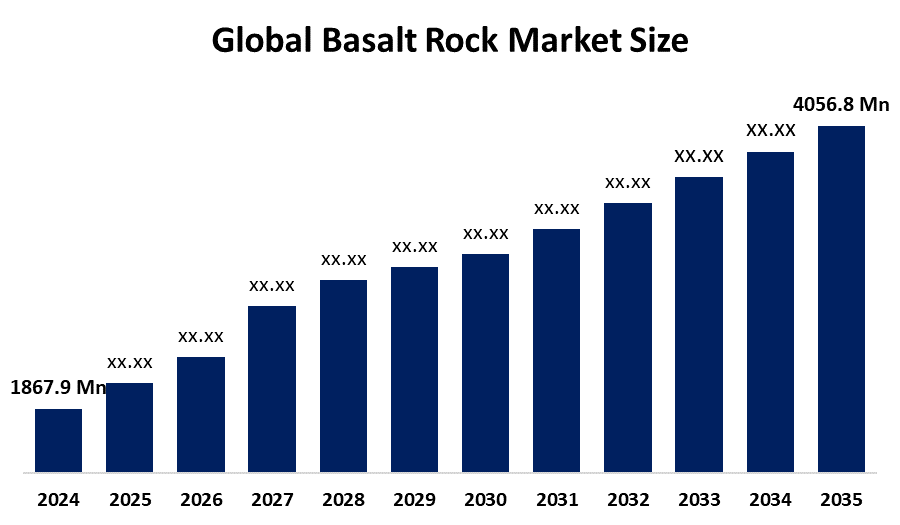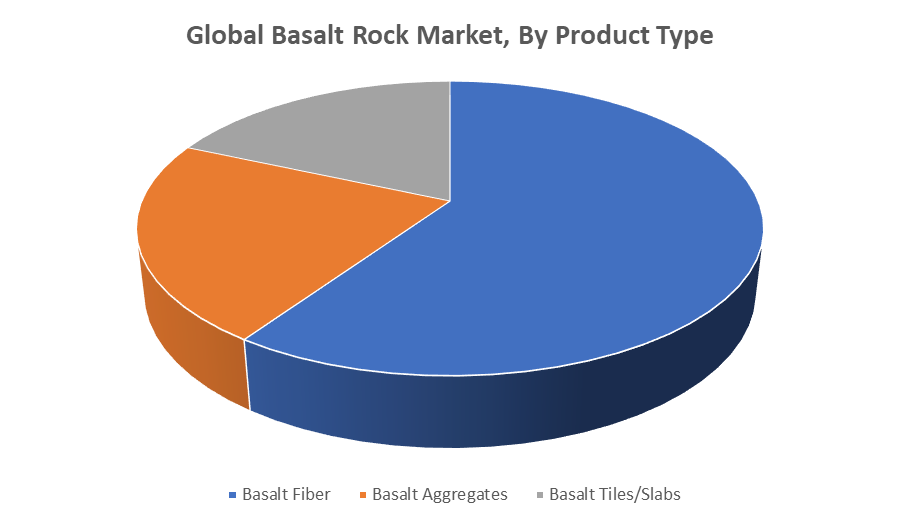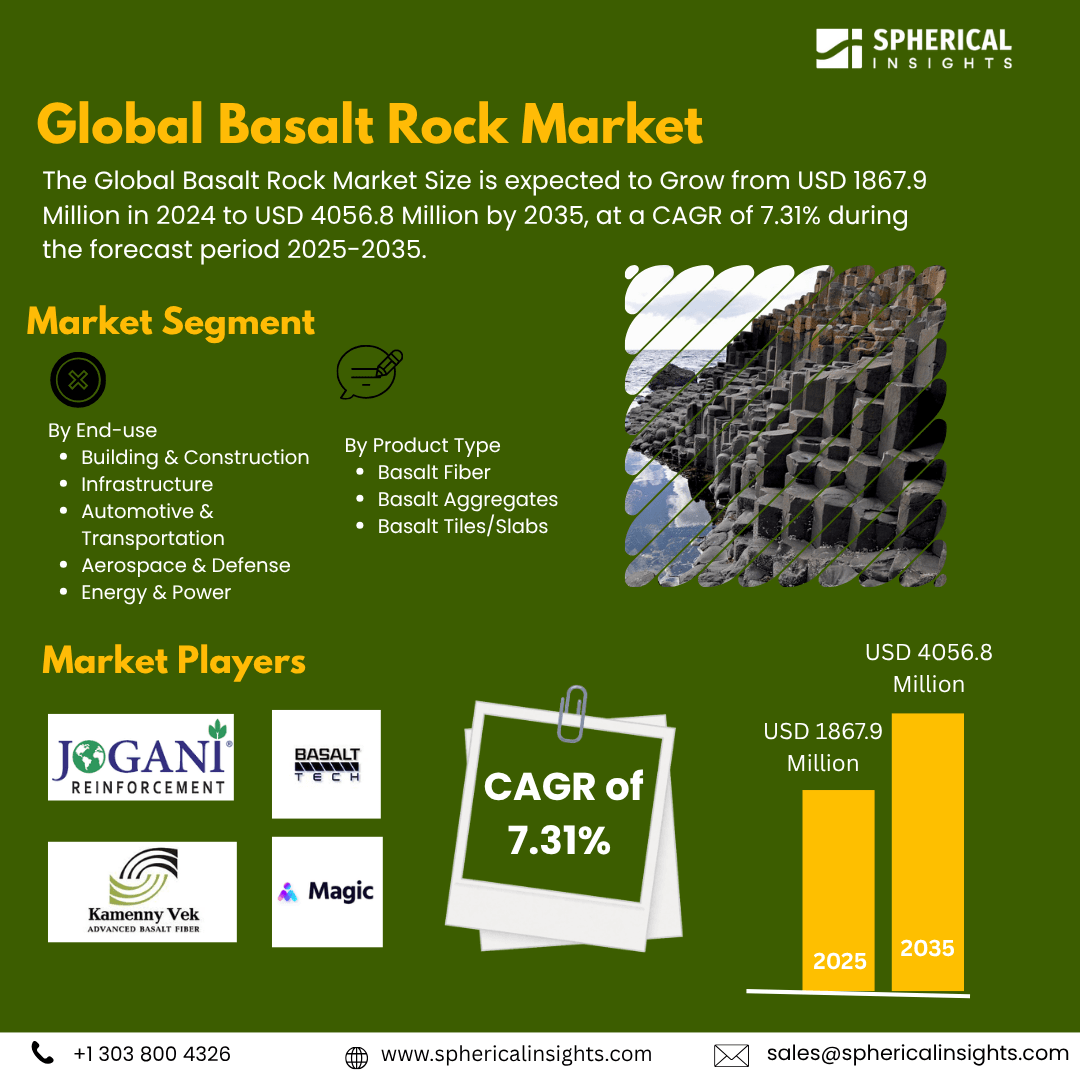Global Basalt Rock Market Insights Forecasts to 2035
- The Global Basalt Rock Market Size Was Estimated at USD 1867.9 Million in 2024
- The Market Size is Expected to Grow at a CAGR of around 7.31% from 2025 to 2035
- The Worldwide Basalt Rock Market Size is Expected to Reach USD 4056.8 Million by 2035
- North America is expected to grow the fastest during the forecast period.

Basalt Rock Market
The Global Basalt Rock Market Size is growing steadily due to its widespread use in construction, road building, insulation, and basalt fiber production. Basalt, a volcanic igneous rock, is valued for its strength, durability, and eco-friendly properties, making it an attractive alternative to traditional materials. Increasing infrastructure development and urbanization worldwide are major drivers of market demand. Governments across various countries are actively promoting sustainable construction practices, encouraging the use of basalt through funding and regulatory support. Initiatives focus on reducing carbon footprints and fostering research into basalt fiber composites, which offer a lightweight and strong substitute for steel and fiberglass. Basalt’s natural abundance and low environmental impact make it a preferred choice in industries like construction, automotive, aerospace, and defense. With growing environmental concerns and the global push toward greener materials, the basalt rock market is expected to see consistent growth, playing a crucial role in future industrial and infrastructure developments.
Attractive Opportunities in the Basalt Rock Market
- The increasing demand for sustainable and eco-friendly construction materials presents an opportunity for basalt rock in insulation and noise reduction applications. Basalt fibers, with their high strength-to-weight ratio, thermal stability, and corrosion resistance, are increasingly being used in these areas, especially in construction, automotive, and aerospace industries.
- Government incentives promoting green infrastructure and carbon footprint reduction are fueling the demand for sustainable materials like basalt. Many countries are funding and supporting research into basalt-based composites and encouraging the use of eco-friendly construction materials in public infrastructure projects.
Global Basalt Rock Market Dynamics
DRIVER: Rising infrastructure development and urbanization
The growth of the global basalt rock market is driven by rising infrastructure development and urbanization, increasing demand for durable and eco-friendly construction materials. Basalt’s natural strength, heat resistance, and low environmental impact make it ideal for roads, buildings, and insulation. Growing adoption of basalt fiber as a sustainable alternative to traditional fibers in the automotive and aerospace industries also fuels market expansion. Government initiatives promoting green construction and funding research into basalt-based composites support further growth. Additionally, basalt’s abundance and cost-effectiveness contribute to its rising popularity, making it a key material in meeting global sustainability and industrial demands.
RESTRAINT: High extraction and processing costs
The global basalt rock market faces restraints from challenges such as high extraction and processing costs, which can limit its competitiveness against cheaper alternatives like concrete and steel. Limited awareness and technical expertise in using basalt fibers in some regions also hinder widespread adoption. Additionally, the availability of basalt deposits is geographically concentrated, leading to supply chain constraints and increased transportation costs. Environmental regulations on mining activities can delay projects and increase operational expenses. Lastly, the relatively slow development of infrastructure in certain emerging markets restricts demand growth, posing challenges to the overall expansion of the basalt rock market.
OPPORTUNITY: Expanding applications in insulation and noise reduction
The global basalt rock market holds significant opportunities driven by growing demand for sustainable and eco-friendly construction materials. Increasing awareness of basalt fiber’s advantages, such as a high strength-to-weight ratio and corrosion resistance, opens new avenues in automotive, aerospace, and defense industries seeking lightweight alternatives to metals and synthetic fibers. Expanding applications in insulation and noise reduction also boost market potential. Additionally, government incentives promoting green infrastructure and carbon footprint reduction create favorable conditions for basalt use. Innovations in basalt fiber production and composite technologies further enhance product performance and cost-efficiency, attracting new industries. Emerging economies investing heavily in infrastructure development provide untapped markets. Collaborations between research institutions and manufacturers can accelerate product adoption, making the basalt rock market a promising sector for sustainable industrial growth.
CHALLENGES: Stringent environmental regulations on mining activities
The basalt rock market faces challenges, including high extraction and processing costs compared to conventional materials, limiting its widespread adoption. Supply chain issues arise due to the geographic concentration of basalt deposits, which increases transportation expenses. Lack of awareness and technical expertise in using basalt fibers in many regions hinders market growth. Additionally, stringent environmental regulations on mining activities can delay projects and raise operational costs. These factors, combined with competition from established materials like steel and concrete, pose significant challenges to market expansion.
Global Basalt Rock Market Ecosystem Analysis
The global basalt rock market ecosystem includes mining companies extracting raw basalt, manufacturers processing it into aggregates, fibers, and construction materials, and end-users in construction, automotive, aerospace, and infrastructure sectors. Governments and research institutions support sustainable development through regulations and innovation funding. Key growth drivers are urbanization and eco-friendly material demand, while challenges include high processing costs and limited technical awareness. Opportunities lie in advanced basalt fiber composites and green infrastructure initiatives. This interconnected ecosystem fuels basalt’s expanding industrial and environmental role worldwide.
Based on the product type, the basalt fiber segment led the market with the largest revenue share over the forecast period

The basalt fiber segment led the global basalt rock market, capturing the largest revenue share throughout the forecast period. This dominance is driven by basalt fiber’s superior strength, durability, and eco-friendly properties, making it a preferred material in construction, automotive, aerospace, and defense industries. Its advantages over traditional fibers like glass and carbon fiber such as better thermal stability and corrosion resistance fuel growing demand. Additionally, ongoing innovations and increased government support for sustainable materials further boost the basalt fiber segment’s market leadership.
Based on the end use, the building & construction segment led the market with the highest revenue share over the forecast period
The building and construction segment led the global basalt rock market, holding the highest revenue share throughout the forecast period. This leadership is due to basalt’s durability, thermal insulation properties, and eco-friendliness, making it ideal for infrastructure projects, roads, and residential and commercial buildings. Increasing urbanization and government investments in sustainable construction further drive demand. The segment benefits from basalt’s ability to replace traditional materials, contributing to greener, more resilient structures and boosting its market dominance.
Asia Pacific is anticipated to hold the largest market share of the basalt rock market during the forecast period
Asia Pacific is anticipated to hold the largest market share of the basalt rock market during the forecast period. This is driven by rapid urbanization, industrial growth, and extensive infrastructure development in countries like China and India. The region’s abundant basalt reserves and increasing adoption of sustainable construction materials further boost market growth. Additionally, government initiatives supporting green building practices and investments in transportation and energy sectors contribute to the Asia Pacific’s dominance in the basalt rock market.
North America is expected to grow at the fastest CAGR in the basalt rock market during the forecast period
North America is expected to grow at the fastest CAGR in the basalt rock market during the forecast period. This rapid growth is fueled by increasing demand for sustainable construction materials, advancements in basalt fiber technology, and strong investments in infrastructure and automotive sectors. Additionally, growing environmental awareness and government incentives promoting eco-friendly building practices contribute to market expansion. The region’s focus on innovation and adoption of basalt composites in aerospace and defense industries further accelerate North America’s market growth.
Recent Development
- In July 2024, Jogani Reinforcement launched high-tensile basalt fiber reinforcement specifically designed for India's concrete and infrastructure sectors. This innovative product aims to enhance the durability and sustainability of construction materials by providing greater strength, corrosion resistance, and thermal stability. The basalt fiber reinforcement is seen as a more eco-friendly alternative to traditional steel rebar, offering improved performance while reducing the environmental footprint. This development is expected to support India's growing infrastructure projects, which are increasingly prioritizing sustainable and resilient building materials.
Key Market Players
KEY PLAYERS IN THE BASALT ROCK MARKET INCLUDE
- Jogani Reinforcement
- Basalt Fiber Tech (BFT)
- Kamenny Vek
- Basalt Engineering
- Shanxi Basalt Fiber Co., Ltd.
- Mafic Inc.
- Xinxing Ductile Iron Works Co., Ltd.
- Hebei Jianxin Basalt Fiber Co., Ltd.
- Hunan Huitian New Materials Co., Ltd.
- Tianjin Dongli Basalt Fiber Co., Ltd.
- Others
Market Segment
This study forecasts revenue at global, regional, and country levels from 2020 to 2035. Spherical Insights has segmented the basalt rock market based on the below-mentioned segments:
Global Basalt Rock Market, By Product Type
- Basalt Fiber
- Basalt Aggregates
- Basalt Tiles/Slabs
Global Basalt Rock Market, By End-use
- Building & Construction
- Infrastructure
- Automotive & Transportation
- Aerospace & Defense
- Energy & Power
Global Basalt Rock Market, By Regional Analysis
- North America
- Europe
- Germany
- UK
- France
- Italy
- Spain
- Russia
- Rest of Europe
- Asia Pacific
- China
- Japan
- India
- South Korea
- Australia
- Rest of Asia Pacific
- South America
- Brazil
- Argentina
- Rest of South America
- Middle East & Africa
- UAE
- Saudi Arabia
- Qatar
- South Africa
- Rest of the Middle East & Africa
FAQs
Q: Which end-use industries are driving growth in the Global Basalt Rock Market?
A: Major end-use industries include Building & Construction, Infrastructure, Automotive & Transportation, Aerospace & Defense, and Energy & Power.
Q: Which region is expected to hold the largest market share in the Basalt Rock Market?
A: Asia Pacific is expected to hold the largest market share due to rapid urbanization, industrial growth, and government support for sustainable materials.
Q: Which region is expected to experience the fastest growth in the Basalt Rock Market?
A: North America is anticipated to grow at the fastest CAGR due to advancements in basalt fiber technology, government incentives, and strong demand in the infrastructure sector.
Q: What are the emerging opportunities in the Basalt Rock Market?
A: Opportunities include expanding applications in insulation, noise reduction, and increased adoption of basalt fibers in automotive, aerospace, and defense industries.
Q: How is the basalt fiber segment performing in the market?
A: The basalt fiber segment leads the market, driven by its superior strength, durability, and eco-friendly properties, especially in construction, automotive, aerospace, and defense industries.
Q: What is the outlook for the Basalt Rock Market from 2024 to 2035?
A: The market is expected to experience steady growth, supported by increasing demand for sustainable construction materials and advancements in basalt fiber technologies.
Q: What government initiatives are promoting the use of basalt in construction?
A: Government incentives focused on green infrastructure, carbon footprint reduction, and sustainable building practices are driving demand for basalt-based materials.
Q: What are the latest developments in the Basalt Rock Market?
A: In July 2024, Jogani Reinforcement launched high-tensile basalt fiber reinforcement for the Indian construction sector, aiming to enhance the durability and sustainability of concrete materials.





